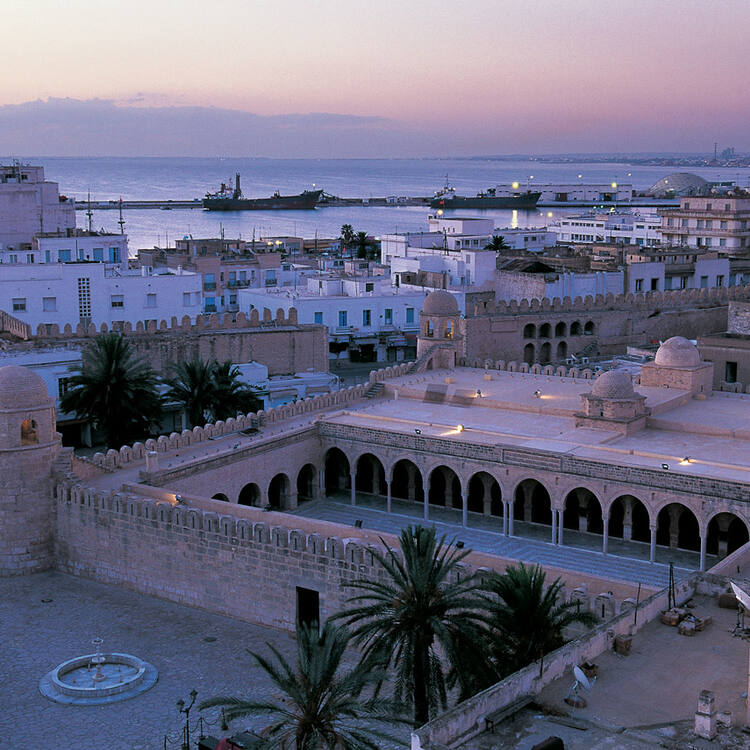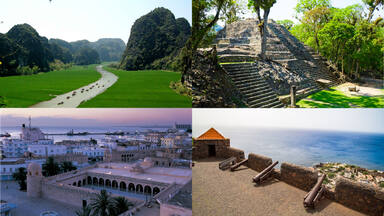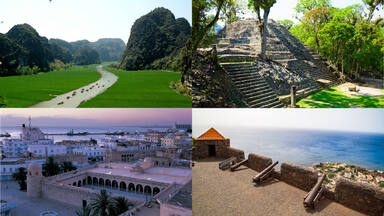Medina of Sousse
Medina of Sousse
Sousse was an important commercial and military port during the Aghlabid period (800–909) and is a typical example of a town dating from the first centuries of Islam. With its kasbah, ramparts, medina (with the Great Mosque), Bu Ftata Mosque and typical ribat (both a fort and a religious building), Sousse was part of a coastal defence system.
Description is available under license CC-BY-SA IGO 3.0
Médina de Sousse
Sousse, important port commercial et militaire sous les Aghlabides (800-909), est un exemple typique de ville des premiers siècles de l'islam. Avec sa casbah, ses remparts, sa médina et sa Grande Mosquée, la mosquée Bu Ftata et son ribat typique, à la fois fort et édifice religieux, elle était l'un des éléments d'un système de défense de la côte.
Description is available under license CC-BY-SA IGO 3.0
كانت سوسة مرفأ تجارياً وعسكرياً هاماً في عهد الأغالبة (800-909)، وهي اليوم نموذج عن مدن القرون الأولى من الاسلام. وقد شكلت في ما مضى عنصراً من نظام دفاعي ساحلي بقصبتها وأسوارها ومدينتها القديمة والمسجد الكبير ورباطها النموذجي الذي يجمع بين وظيفته كقلعة وكنصب ديني.
source: UNESCO/CPE
Description is available under license CC-BY-SA IGO 3.0
在阿克拉普王朝时代(公元800-909年),苏塞就是重要的贸易枢纽和军事港口。在伊斯兰世界最初形成的几百年中,苏塞是一个典型的伊斯兰城镇。城内有旧城区、防御工事、阿拉伯人聚居区(并建有大清真寺)、伊斯兰教修道院和典型的里巴特(既有军事功能又有宗教意义的男修道院)。苏塞是伊斯兰国家沿海防御系统的一个重要组成部分。
source: UNESCO/CPE
Description is available under license CC-BY-SA IGO 3.0
Сус, важный торговый и военный порт в период Аглабидов (800-909 гг.), является типичным примером города, относящегося к первым столетиям распространения ислама. Сус, со своими касбой, стенами, мединой (с Большой мечетью), мечетью Бу-Фатата и характерным «рибатом» (одновременно фортом и зданием религиозного назначения), являлся частью прибрежной оборонительной системы.
source: UNESCO/CPE
Description is available under license CC-BY-SA IGO 3.0
Medina de Susa
Importante puerto comercial y militar en tiempos de los aglabíes (800-909), Susa formó parte de un dispositivo de defensa de las costas y es un ejemplo característico de las ciudades construidas en los primeros siglos del Islam. Ha conservado la kasba, las murallas, la medina con la Gran Mezquita, la mezquita de Bu Ftata y la típica rábida.
source: UNESCO/CPE
Description is available under license CC-BY-SA IGO 3.0
スース旧市街
source: NFUAJ
Medina of Sousse
De medina van Sousse ligt in het Tunesische gedeelte van de Sahel. Het vormt een harmonieus archeologisch complex dat de Arabisch-Islamitische stedenbouw reflecteert, toegepast op een kustplaats die te maken had met piraterij en andere gevaren van de zee. Sousse was een belangrijke commerciële en militaire haven tijdens de Aghlabidperiode (800-909) en maakte deel uit van een kustverdediging. Bezienswaardigheden in Sousse zijn de kashba, verdedigingsmuren, de Bu Ftata-moskee, de ribat (zowel een fort als een religieus gebouw) en de medina. De medina – met daarin de Grote Moskee – bestaat uit naast elkaar geplaatste woningen gescheiden door kronkelende steegjes en smalle paadjes.
Source: unesco.nl
Outstanding Universal Value
Brief synthesis
Located in the Tunisian Sahel, the Medina of Sousse constitutes a harmonious archaeological complex that reflects Arabo-Muslim urbanism applied to a coastal town exposed through its history to piracy and dangers from the sea. With the Medina of Monastir, it constitutes the unique prototype of military coastal architecture of the first centuries of Islam that has been passed down to us. Several monuments of the medina bear witness to this robust, ascetic and imposing architecture, notably the Ribat, the Great Mosque, the Bou Ftata Mosque, the Kasbah and the ramparts. The Ribat, both a fort and a religious building, is an eminent example of this type of construction. The Medina also comprises juxtaposed dwellings divided into quarters that separate the winding alleys and narrow paths, a fast disappearing type of layout threatened by modern life and the evolution of architectural techniques. It also contains an ensemble of unique monuments dating from Aghlabid and Fatimid times, enabling study of the evolution of Islamic art in its first period.
Criterion (iii): With the Ribat, the Kasbah, ramparts, Bou Ftata Mosque and the Great Mosque, the Medina of Sousse bears exceptional witness to the civilization of the first centuries of the Hegira. The Medina was conceived according to a regular plan with its meridian axis running from Bab el Kabli to the ribat and the ancient interior port, and its east-west axis running from Bab el Jedid to Bab el Gharbi. It constitutes a precocious and interesting example of an Islamic city.
Criterion (iv): The most ancient and best conserved of all, the Ribat of Sousse, is an outstanding example of this type of construction, with its rectangular enclosure flanked with towers and turrets, pierced with a single gate on the south, an inner courtyard rising over two levels with thirty-five cells opening onto it, a mosque on the southern side of the first storey, with its south-east facing tower, added in 821, serving as both a minaret and watch tower, from where signals from the Ribat could be transmitted to Monastir.
Criterion (v): The Medina of Sousse constitutes an outstanding example of Arabo-Muslim and Mediterranean architecture that reflects a particular traditional way of life. This typology, which has become vulnerable through the impact of irreversible socio-economic changes and modern life, constitutes a precious heritage that must be safeguarded and protected.
Integrity (2009)
The boundaries of the property correspond to the surrounding wall of the town and include all the important attributes.
The historic urban ensemble of the town of Sousse has conserved, without major alteration, its urban fabric with its spatial morphology and its monumental, architectural and architectonic components. However, new developments outside the boundaries threaten the visual integrity of this coastal fort.
Authenticity (2009)
Adaptation to new life styles and socio-cultural and economic demands as well as the restoration and renovation work carried out over the centuries have not affected nor perturbed its intrinsic functional and structural authenticity. However, new challenges arise when a balance between the function, the needs of the inhabitants, heritage questions and the need for new buildings, needs to be found Authenticity is particularly vulnerable due to inappropriate conservation and inadequate new constructions.
Protection and management requirements (2009)
The Medina of Sousse benefits from three levels of national protection including a local and municipal protection system. In addition to the large number of monuments benefiting from specific listing as historic monuments (Kasbah, Great Mosque, Ribat, Soufra, Bou Ftata Mosque, etc.), the property is protected by Law 35-1994 concerning the protection of archaeological and historic heritage and traditional arts, by the Law concerning urban town planning and by the Municipal Order concerning construction permits inside the Medina of Sousse. A structure attached to the National Heritage Institute is permanently responsible for the safeguarding of the property and its management. Control measures to reduce the impact of interventions on the historic monuments and that of new developments on the ensemble of the property should be introduced on a strictly permanent basis. Conservation interventions also need to be carefully and continuously controlled. The proposed buffer zone shall extend over 200 m beyond the ramparts and should be subject to constraints as regards adequate planning to preserve the visual integrity of the property.




